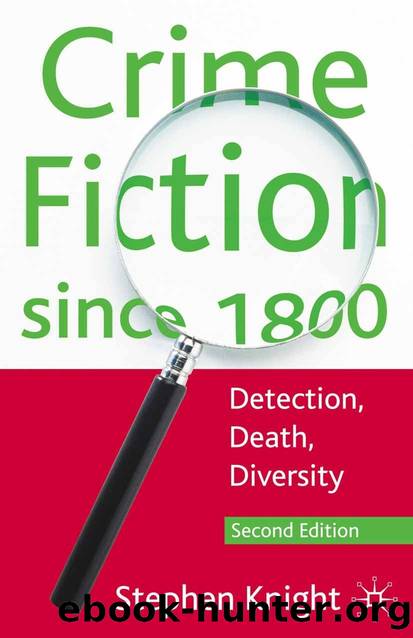Crime Fiction since 1800 by Stephen Knight

Author:Stephen Knight
Language: eng
Format: epub
Publisher: Macmillan Education UK
VI THE âTOUGH GUYâ ABROAD
The private-eye form has long been imitated in American culture and around the world, but one of its earliest international locations has been, it seems, almost completely forgotten. Some British writers turned their hand to the private-eye story in the spirit, like the New York clue-puzzlers, of transatlantic imitation. James Hadley Chase and Peter Cheyney cranked out vaguely set and linguistically bizarre quasi-American thrillers in the late 1930s. The great surprise was Chase: actually named René Raymond, he was in the book trade when he decided to try the âtough guyâ approach. No Orchids for Miss Blandish (1939), in spite of its society-sounding title, was a grimly realistic and sadistic story set in the American south and with some elements of Faulkner in it, especially the plot of Sanctuary (1930): a probable further source was the recent Thieves Like Us by Edward Anderson (1937). It had pace and vigour â George Orwell, while disapproving of the bookâs value-free Americanism, as he saw it, still called it âa brilliant piece of writingâ ([1944] 1984: 30). The violence, sex and above all the sadism made it both a banned and a bestselling book. As Horsley notes (2001: 157â8), Chase continued to produce into the 1980s novels that were increasingly focused on sex rather than violence, though in 1961 he produced a heavily cut version of his famous novel for the English market. He did occasionally show greater subtlety, as in Trusted Like the Fox (1948, first published as by âRaymond Marshallâ) which deals with a war-maddened British veteran who is a worse criminal than a pro-Nazi traitor, an interesting theme from Chase, who had served with distinction in the Royal Air Force throughout the war.
Less well known than Chase was Carter Brown â actually Alan G. Yates, a mild-mannered businessman who, after war service in the British navy, settled in Sydney and turned out a huge flow of tough-guy novellas for publishing houses first in Australia and then around the world. His joke-like titles (Strip without Tease (1953) and Homicide Hoyden (1954) are typical), his euphemised violence, and a focus on rich food rather than sex all seemed to target an early adolescent audience. Carter Brown showed how the private-eye form had a world-wide audience, but retained an American form â his stories were set in a vague imaginary USA.
One English writer went further, at least in geographic terms. Peter Cheyney was once very well known indeed, but now is almost completely overlooked, and out of print. During the war his sales matched Christieâs, and he established himself before Chase as a pasticheur of Hammettesque thrillers â he started before Chandler had published a novel. This Man is Dangerous (1936) introduced Lemmy Caution to a British audience â first located in London but soon reverting to the USA. It was published in New York in 1938, with some success â according to his biographer Michael Harrison his sales there reached 300,000 a year, which, intriguingly, was only a third of his sales in France (1954: 274).
Download
This site does not store any files on its server. We only index and link to content provided by other sites. Please contact the content providers to delete copyright contents if any and email us, we'll remove relevant links or contents immediately.
4 3 2 1: A Novel by Paul Auster(11101)
The handmaid's tale by Margaret Atwood(6895)
Giovanni's Room by James Baldwin(5936)
Big Magic: Creative Living Beyond Fear by Elizabeth Gilbert(4763)
Asking the Right Questions: A Guide to Critical Thinking by M. Neil Browne & Stuart M. Keeley(4625)
On Writing A Memoir of the Craft by Stephen King(4249)
Ego Is the Enemy by Ryan Holiday(4021)
Ken Follett - World without end by Ken Follett(3992)
The Body: A Guide for Occupants by Bill Bryson(3863)
Bluets by Maggie Nelson(3743)
Adulting by Kelly Williams Brown(3704)
Guilty Pleasures by Laurell K Hamilton(3618)
Eat That Frog! by Brian Tracy(3548)
White Noise - A Novel by Don DeLillo(3453)
The Poetry of Pablo Neruda by Pablo Neruda(3388)
Alive: The Story of the Andes Survivors by Piers Paul Read(3335)
The Book of Joy by Dalai Lama(3258)
The Bookshop by Penelope Fitzgerald(3249)
Fingerprints of the Gods by Graham Hancock(3240)
